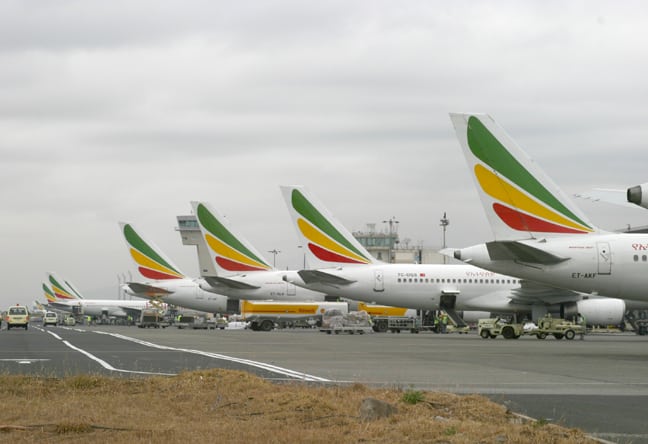[Avionics Today 08-10-2015] Ethiopian Airlines has announced plans to order 44 new aircraft, effectively doubling its 76-plane fleet in the face of rising air traffic as Africa’s economy sees steady growth. To accommodate the projected rise, the African carrier has implemented “Vision 2025,” a fleet expansion plan that aims to add 20 Boeing 737 MAX 8s, 14 A350-900s, six Boeing 787 Dreamliners, two Boeing 787-9s, and two 777-200F Boeing freighters to its fleet over the next decade. The airline is also in the process of evaluating the Boeing 777X, Airbus 350-1000, and Bombardier Q400 aircraft, with the target to reach a 150-aircraft fleet by 2025.
 |
| Ethiopian Airlines aircraft tails. Photo: Ethiopian Airlines |
“Africa’s economy has grown at a rate of more than 4.5 percent per year over the past 10 years despite the global recession. As a result, two-thirds of the countries in Africa are now classified as middle income or higher, according to the World Bank,” Nigusu Worku Wordofa, regional director of the Americas for Ethiopian Airlines, told Avionics Magazine. “In line with this growth, overall air traffic to and from Africa is expected to grow by about 6 percent annually over the next 20 years as new airplane technology increases efficiency and opens new international routes from high-altitude hot airports in Africa.”
With the African economy expected to rise at an average 6 percent Gross Domestic Product (GDP) per year, and reports showing growth in Sub-Saharan economies that will match or surpass the global rate, the state-owned airline is poising itself to take advantage of the continent’s rising middle class added opportunity in the aviation sector, according to Worku. The continent’s economy is still suppressed, however, due to a decline in oil revenue and security threats in some regions, but the company sees continued growth in its future.
“Africa has rich reserves of precious metals, large oil reserves, and 60 percent of the world’s arable and uncultivated land, which has attracted huge investments and trade with the rest of the world,” said Worku. “This, in turn, has increased travel to and from the continent and also increased the number of middle class society in Africa, which has disposable income and propensity to travel by air.”
In the last year, Ethiopian Airlines has seen a 7 percent jump in air traffic — from the second quarter of 2014 to the second quarter 2015. Domestic travel has picked up at an estimated 20 percent year-over-year, supplemented by strong in-country routes such as Mekelle and Bahir-dar and other in-continent flight routes, such as those to Kenya, the Republic of Sudan, Nigeria, and South Africa.
International traffic has picked up slower — just 3 percent year-over-year — but Worku notes that the airline sees heavy traffic on international routes to America and Dubai. Ethiopian Airlines also expects a further pick up in international traffic to and from countries that are on their way to becoming main trade partners with Africa, such as India, China, and other Asian countries, Japan, Singapore, South Korea, and Vietnam, to name a few. The African carrier is currently flying to 91 international destinations across five continents and has plans to expand to more than 146 destinations worldwide with the planned aircraft additions. With the airline set to exploit growth in both economics and air traffic, Worku believes the continent’s lacking aviation infrastructure still poses yet another barrier to successful expansion.
“There is much to be done in filling the gap for limited infrastructure in Africa and African governments should focus on investing more in infrastructure, deploying latest technology, employing innovation, and strong partnerships among African airlines, which would avoid the worrying trends and challenges facing African air transportation,” he said. “The future is bright for Africa and the 21st century is an African century; the same is true for African aviation but governments should give due attention for infrastructure development.”